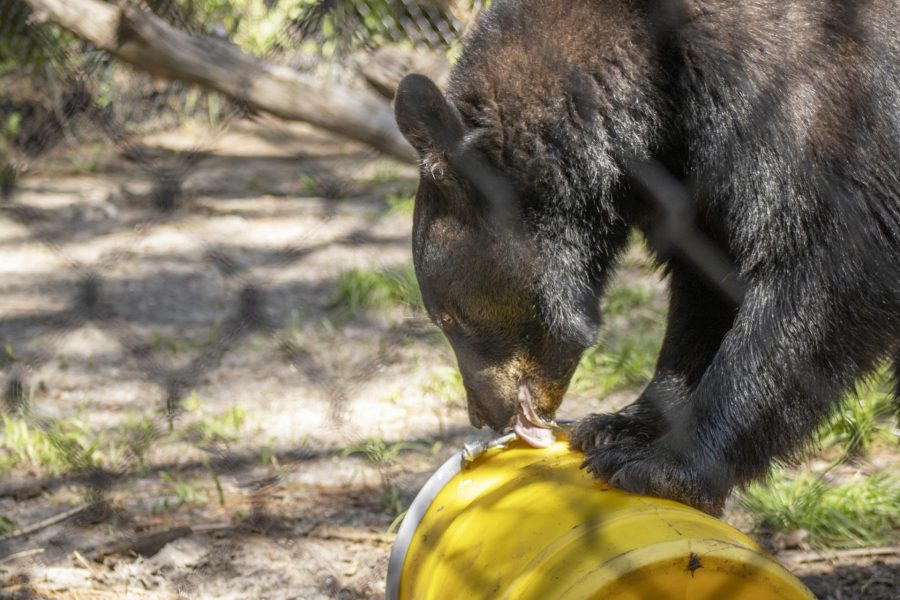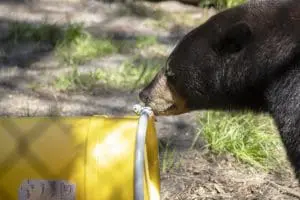

You’ve already met one of our expert testers!
Faced with a bright yellow canister filled with nuts and watermelon, Cheyenne the Florida black bear took her time trying to break into the sealed can. After rolling it with no luck, she carefully tried to pry it open at the can’s lip. No luck.

Testing out bear-resistant products is tasty work!
Then, it was Brody the black bear’s turn. After sniffing, licking and rolling the can, he suddenly grabbed it in a bear hug, stood up and brought the canister down with a smash. Off popped the lid, and Brody settled in for a picnic.
This wasn’t just a special enrichment opportunity for our Brody and Cheyenne. Just on the other side of the fence, our bears’ animal care team and a representative with Florida Fish and Wildlife Conservation Commission’s Bear Research Program watched them take turns with the canister.
Brody and Cheyenne are just two of several bears in zoos and rescue facilities who test garbage cans, food storage bins/lockers, coolers, and any other small to medium-sized containers that are designed to keep bears out of food or garbage. Our bears are doing this on behalf of the Black Bear-Resistant Product Testing Program’ run by the Wildlife Management Institute (WMI) and overseen by Southeastern Association of Fish and Wildlife Agencies (SEAFWA).
Their participation will help identify effective items for the public to use – and hopefully lower the rate of negative interactions between people and bears in their natural range.
“When bears break into garbage cans and raid camp areas, it can be dangerous for humans but often times it’s the bears that suffer,” said Lauren Hinson, our director of animal programs. “These bears get labeled nuisance bears and are often euthanized. Having a product a bear cannot get into will deter them from revisiting the area and keep the bear safe.”
Bears are all about finding food, Lauren said. Their natural diet consists of large amounts of small foods such as berries and acorns. It takes eating enough of these foods to maintain body weight, for reproduction, and to go through torpor – even in Florida, food can become scarce in the winter months.
In the fall, bears try to eat as many as 20,000 calories a day. If they relied on acorns for those calories, they would have to pick up 5,000 acorns to meet that caloric need, said Dave Telesco, the co-chair of the Bear-Resistant Product Testing Committee for (SEAFWA). Compared to the amount of calories they can get from a garbage can, the extra effort to break into a can is still less than foraging for natural foods in many cases.
“Bears lives revolve around taking in as many calories as possible with the least amount of effort, which is why we say bears are ‘smart enough to be lazy,’” Dave said.
This makes bears especially persistent when faced with the feast that can be found in a garbage can or cooler. That food-driven nature coupled with their strength and intellect, make it crucial to use real bears in these tests.
“There is no other way to accurately get the results without using bears,” Lauren said. “The strength they have, the claws and teeth, and ability to manipulate things is unlike any other animal.”
 In between testing the items, Brody and Cheyenne will start getting some different enrichment to help them become expert testers. Right now, their enrichment items encourage the duo to roll the items to receive food.
In between testing the items, Brody and Cheyenne will start getting some different enrichment to help them become expert testers. Right now, their enrichment items encourage the duo to roll the items to receive food.
The most effective way to decrease conflicts between people and bears is to prevent bears from associating getting food with people, whether it’s a food locker in the backcountry in the bear’s natural habitat or a garbage can in the suburbs, Dave said.
“If we can develop products that most bears cannot easily access, we can break that cycle for bears, so they don’t have a reason to associate people with food and therefore maintain their natural wariness of us,” Dave said.
If you live in an area populated with bears, it might be a good idea to assess your garbage cans. Here are Dave’s tips:
- The no-cost method to keeping bears out of your garbage is to keep trash cans in a secure location like a garage or sturdy shed until the morning of waste pick up. See the FWC website for directions on multiple types of sheds. Residents who have a waste service provider must check with them to be sure they are willing to open a shed to empty the garbage. Residents can also deter bears from accessing their trashcans by storing the can inside an electric fence or on top of an electric unwelcome mat.
- To modify your can and make it more bear-resistant, the can and lid must be sturdy and not overly flexible. Most 64- and 95-gallon cans that waste service companies provide their customers are sturdy enough to modify. The Florida Fish and Wildlife Conservation Commission (FWC) has directions for two different ways to modify a sturdy trash can to make it more bear-resistant. However, it’s important to note that a resident needs to check in with their waste service provider to be sure they are allowed to modify the can. Also, the resident must unlatch their modified can themselves so the waste service company can empty it.
- If you did not receive a can from a waste service provider, check its sturdiness by laying the can on its side and standing or sitting on it. If the can collapses of significantly bends, then it cannot be modified to keep bears out. Test the lid as well, if the person can bend the lid significantly then that is not one that can be modified.
Brevard Zoo is an independent, not-for-profit organization that receives no recurring government funding for our operating costs. Your generous support enables us to continue to serve our community and continue our vital animal wellness, education and conservation programs.
